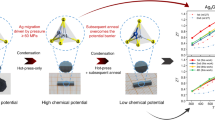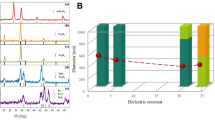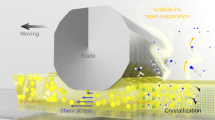Abstract
THE mechanical action of simple laboratory grinders, mortars and similar devices has occasionally been used to assist in chemical reactions in addition to performing their primary physical functions. Among these chemical reactions are phase transformations. That the effect is due to some kind of a pressure component in the mechanical action may appear obvious, but the magnitude of the pressures is not readily appreciated, nor can it be calculated or measured. However, in the course of work in this laboratory on the high-pressure polymorphism of lead dioxide (PbO2), the information that a phase identical with the new high-pressure polymorph, which had been shown to be stable only in the region above 10,000 bars, had been formed by simple grinding1 was noted with no little surprise. The observation was promptly confirmed by grinding a small amount (2 gm.) of the common rutile form (I) of lead dioxide in a mechanical mortar and pestle combination of laboratory pattern. Grinding in air for a few hours converted an estimated one-third to the denser orthorhombic form (II). After preliminary work, it transpired that nothing new in principle had been added to some similar results which had been reported by Burns and Bredig2 on the transformation of calcite to aragonite by grinding in a mortar. The high-pressure phase was formed from the low-pressure one, the amount of change was dependent on time, and subsequent heating would form the low-pressure phase. A significant difference is that phase equilibrium and thermochemical studies3 place the calcite–aragonite transformation at about 3,000 bars at room temperature, which is considerably lower than the 10,000 bars necessary for the lead oxide I ⇌ II transformation.
This is a preview of subscription content, access via your institution
Access options
Subscribe to this journal
Receive 51 print issues and online access
$199.00 per year
only $3.90 per issue
Buy this article
- Purchase on SpringerLink
- Instant access to full article PDF
Prices may be subject to local taxes which are calculated during checkout
Similar content being viewed by others
References
Zaslavsky, A. I., Kondrashov, Y. A., and Tolkachev, S. S., Doklady Akad. Nauk., 75, 559 (1950). Bode, H., and Voss, E., Z. Elektrochem., 60, 1053 (1956).
Burns, J. H., and Bredig, M. A., J. Chem. Phys., 25, 1281 (1956). At the time of oral presentation (see ref. 5) of this work, Prof. J. Goldsmith directed our attention to his work with J. C. Jamieson on the grinding of magnesian calcites, etc., reported orally at the American Crystallographic Association, Milwaukee meeting, 1958.
MacDonald, G. J. F., Amer. Min., 41, 744 (1956). Jamieson, J. C., J. Chem. Phys., 21, 1385 (1953). Clark, S. P., Amer. Min., 42, 564 (1957).
Dachille, F., and Roy, R., J. Amer. Ceram. Soc., 41, 78 (1959).
Dachille, F., and Roy, R., oral presentation, Geol. Soc. Amer., Pittsburgh meeting, November 3 (1959).
Dachille, F., and Roy, R., Z. Krist. (in the press).
Author information
Authors and Affiliations
Rights and permissions
About this article
Cite this article
DACHILLE, F., ROY, R. High-pressure Phase Transformations in Laboratory Mechanical Mixers and Mortars. Nature 186, 34 (1960). https://doi.org/10.1038/186034a0
Issue date:
DOI: https://doi.org/10.1038/186034a0
This article is cited by
-
Magneto-strain effects in 2D ferromagnetic van der Waal material CrGeTe\(_3\)
Scientific Reports (2023)
-
Structural and luminescence characterization of β-Ga2O3 nanopowders obtained via high-energy ball milling
Applied Nanoscience (2023)
-
Pigments—Lead-based whites, reds, yellows and oranges and their alteration phases
Archaeological and Anthropological Sciences (2022)
-
Effect of ball collision direction on a wet mechanochemical reaction
Scientific Reports (2021)
-
Compression of curium pyrrolidine-dithiocarbamate enhances covalency
Nature (2020)



